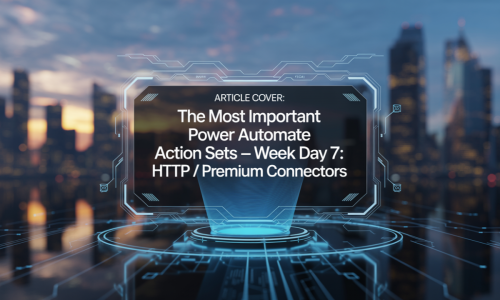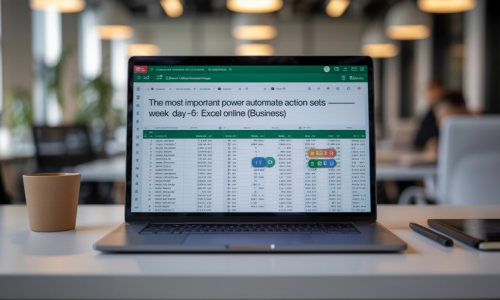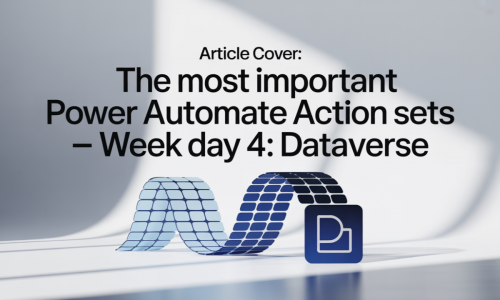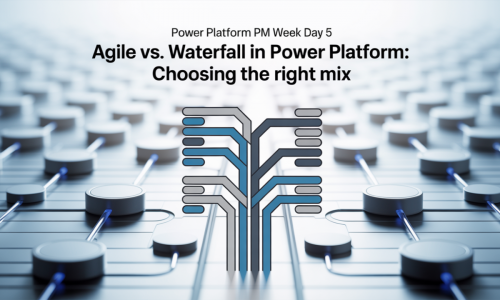Power Platform Bad Decision Week Day 1 – Build First, Ask Questions Later: Why Governance Is Always 'Next Month'
-
Admin Content
-
Oct 03, 2025
-
238
Welcome to Day 1 of Power Platform Bad Decision Week — a series exploring the common, often humorous missteps organizations make when adopting Microsoft Power Platform. Today’s topic? A fan favorite: the impulse to build first, ask questions later, and why governance is always postponed to “next month,” which, of course, never comes.
Let’s dive into this not-so-hypothetical scenario, where good intentions pave the road to chaotic environments, sprawling apps, and panicked Teams chats titled “Who owns this Flow?!”
The Temptation of the Quick Win
One of the biggest allures of the Power Platform is just how easy it is to get started. With a few clicks and some drag-and-drop magic, anyone can create an app or automate a process. It’s empowering. It’s fast. It’s addictive.
This low barrier to entry is exactly why so many teams dive headfirst into building without considering the long-term implications. When the pressure is on to deliver a solution yesterday, governance feels like a bureaucratic hurdle — something for later, when there’s more time. The problem is, there’s never more time. Once you start shipping apps and Flows into production without oversight, you begin to accumulate what we call “governance debt” — the administrative, security, and compliance chaos that’s waiting just around the corner.
The irony? That quick win often turns into a long-term headache. By skipping questions like Who owns this app?, What data is being used?, and What happens if this Flow fails?, you’re building on a shaky foundation. And like any unstable structure, it will eventually collapse — usually during a business-critical moment.
The Myth of the “Temporary Fix”
A common justification for skipping governance is the idea that a solution is only temporary. You’ll hear things like, “We’ll replace it later,” or “This is just for now.” But temporary solutions have a way of becoming permanent fixtures. Months or even years later, these “temporary” apps are still in use, holding together business processes with digital duct tape and sheer optimism.
These Band-Aid builds often live in personal environments, built by enthusiastic citizen developers with no visibility from IT. When that developer leaves the company or forgets to update a connection, the process breaks — and nobody knows why. This isn’t hypothetical; it happens constantly. And what’s worse, the longer these solutions run, the more dependent the business becomes on them.
Governance isn’t about slowing things down; it’s about ensuring your solutions are sustainable. If you wouldn’t let an intern deploy a production server without documentation, access controls, and a support plan, why would you let anyone publish an app that manages HR onboarding without the same oversight?
Why Governance Feels Like an Afterthought
So why do organizations keep pushing governance to “next month”? A few reasons stand out. First, governance sounds boring. It's not as exciting as demoing a shiny new dashboard or showing off an AI-powered automation. Second, many teams don’t have a clear owner for Power Platform governance. Is it IT? The business unit? A Center of Excellence (CoE) that’s still in the planning stage?
This lack of clarity leads to delays. Add in the perception that governance is a blocker rather than an enabler, and it’s easy to see why it gets deprioritized. Teams want speed. Governance, in their eyes, slows them down.
But this mindset is backwards. Good governance isn’t about control — it’s about support. When implemented properly, it helps makers move faster and safer. It provides templates, guidelines, environment strategies, and support frameworks that reduce friction and increase adoption. In other words, it helps good ideas scale without creating a dumpster fire.
The Hidden Costs of Chaos
Skipping governance may save time upfront, but it comes at a cost. Without proper oversight, organizations end up with:
- Dozens (or hundreds) of unmanaged apps
- Data leakage through unsanctioned connectors
- Security gaps from poorly configured environments
- Support nightmares when solutions break unexpectedly
- Compliance risks when sensitive data is mishandled
These issues aren’t just inconvenient — they’re expensive. IT teams eventually have to clean up the mess, often without knowing what they’re walking into. This firefighting drains resources, delays other projects, and can severely undermine confidence in the platform.
Worse, it may cause leadership to clamp down entirely, stifling innovation. This “overcorrective lockdown” often happens after a governance failure — when the business realizes the Wild West approach doesn’t scale and panic sets in. By then, it’s far harder (and costlier) to course correct.
Building the Governance Muscle (Before It’s Too Late)
The good news? It’s never too late to start governing smarter — but earlier is always better. Building governance into your Power Platform adoption plan from day one doesn’t mean endless red tape. Start small:
- Define environment strategies for development, testing, and production
- Set clear ownership models and support responsibilities
- Monitor app and Flow usage with analytics
- Educate makers on best practices and guardrails
- Automate approvals and policy enforcement where possible
You don’t need to launch a full Center of Excellence overnight. Even basic policies — like who can create environments, or how data loss prevention policies are applied — make a huge difference. The key is to treat governance as an enabler, not a blocker.
If you approach it like a gym routine — building strength over time — it becomes part of your organization’s digital muscle memory. Eventually, good governance isn’t something you “add later”; it’s just how you work.
Bad Decisions Make Great Stories — If You Learn From Them
Let’s face it: every Power Platform admin has a story (or ten) about a rogue app, a broken Flow, or a mystery environment with no owner. These tales are part of the platform’s growing pains — and they’re not going away.
But the lesson from Day 1 of Bad Decision Week is clear: building without governance might feel fast, but it’s a false economy. Sooner or later, you’ll have to face the consequences. The smarter move? Start thinking about governance not “next month,” but right now.
And if you’ve already made the bad decision? Don’t panic — just don’t make it again. Because every bad decision is an opportunity to do better next time.





